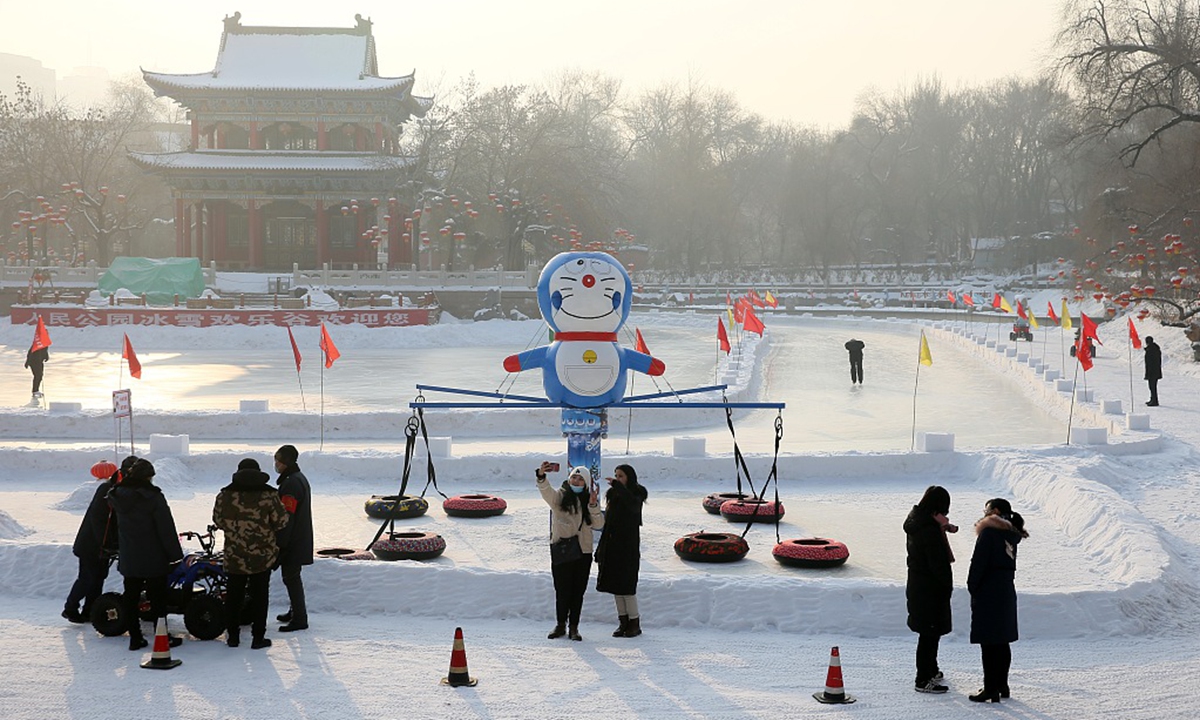It's a shame for WSJ to attack China on ethnic affairs while US sinks in racial strife

People enjoy their time on Friday, New Year's Day at a park in Urumqi, Xinjiang Uygur Autonomous Region. Photo: VCG
The year 2020 has witnessed the complete dysfunction of US' political and social systems. It is suffering from at least two viruses. The first is the novel coronavirus. And the second is a severe chronic disease in US society - racism. Unfortunately, leaving the two grave challenges behind, The Wall Street Journal (WSJ) rolled out a lengthy piece to castigate China on the very last day of the year, alleging that "Beijing Accelerates Campaign of Ethnic Assimilation."
The headline is eye-catching and akin to the sickening story from February 2020 that the WSJ put on their website, entitled, "China is the Real Sick Man of Asia."
Accusing Beijing of pushing for ethnic assimilation, the story is nothing but pure fabrication. Its content is made up of baseless allegations and attacks that have been repeated by Western media outlets time and again. It claimed that China's government is applying "high-tech police surveillance" to "watch on and control" the country's minority populations. Moreover, it accused a new Chinese regulation in Inner Mongolia - encouraging Mandarin-language education - as an attempt to "erase" the local Mongolian language.
It is not surprising that the WSJ intentionally skipped the government's earnest efforts to root out terrorism in Xinjiang. Nor will it ever acknowledge that the "mass detention" facilities claimed by them are actually vocational education and job training institutions and schools. Over the years, steps have been taken in the region to help local people learn languages, study laws and acquire skills so that locals can distance themselves from the influence of religious extremism and return to making a decent life.
Today, not only has Xinjiang seen a growing sense of security and stability among its residents, Xinjiang's local employment rate has sharply increased. Also, the gap between the rich and poor is narrowing in the region.
The WSJ does not mention that installing public surveillance facilities is a common practice by governments worldwide to maintain security and social stability. Official data shows that as early as in 2010, there were 4.2 million surveillance cameras in Britain, accounting for 25 percent of the world's total. Citywide surveillance systems have also been launched throughout the US states targeting pedestrians and vehicles. In many US media reports, the same facilities are justified, necessary to improve public security and make streets safer in the US and UK. But why are they described as unjustified in China? Why are they said to be used for controlling ethnic minority groups and encouraging assimilation? Aren't these double standards too obvious?
The WSJ deliberately skirted around the fact that Beijing did not force students in Inner Mongolian to give up the Mongolian language at all. It turned a blind eye to this fact: new local regulations have not changed its bilingual education system. And the newspaper will never acknowledge that learning Putonghua can boost local students' opportunities for more access to education, enhance communication with other tribes of the country, and improve their employment prospects.
Anyone who has lately been to Xinjiang or Tibet knows that, nowadays, terrorist assaults, underground killings, and economic degradation cannot be found anywhere at all. For many years, Chinese ethnic minorities have been enjoying preferential policies in childbirth and education. Local people's living standards are constantly rising. China's outlying ethnic provinces are becoming thriving regions.

Demonstrators take part in a "Black Lives Matter" protest commemorating Juneteenth in the Brooklyn borough of New York, the United States. File Photo: Xinhua
By contrast in the US, the tragedy of George Floyd, an African-American man who died in May after being pinned to the ground by a white police officer's knee, triggered an outbreak of violent protests against vicious racism across the country. The whole world clearly sees that in the US, the color of one's skin still plays a vital role in determining an American's fate. There has been no substantial improvement for American people of color over the years.
The basic human rights of minorities in the US have been trampled on. "Black men are 2.5 times more likely than white men to be killed by police during their lifetime," US science journal Nature reported in June. Worse, the Equal Justice Initiative, a US-based non-profit organization once found that "young black men are 21 times as likely as their white peers to be killed by police" in the US.
Because of long-lasting racial discrimination, American minorities are in a comprehensive disadvantaged position in terms of employment. Reports show that African Americans' unemployment rate is twice as high as that of whites. And people of color are much more often seen in homeless shelters across the US.
Yet the US media outlets like the WSJ are oblivious to the poor status of American minorities. It is a shame for it to fabricate a long story, intentionally slinging dirt at China, an increasingly better-off country that has made marked progress on ethnic coexistence and unity, common growth and co-prosperity, while neglecting the endless racial strife at home.
The author is a reporter with the Global Times. opinion@globaltimes.com.cn




